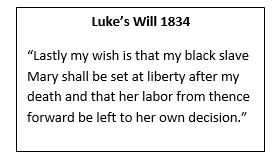1761 – 1834
Luke Hazlewood of Lunenburg, Virginia grew up as a farm boy on Reedy Creek. During the Revolutionary war, he and his older brother, Benjamin enlisted in the state militia. Luke served a total of twelve months under such famous generals as Horatio Gates, Baron von Steuben, and George Washington. (Note that his government records use the spelling “Hazelwood.”)

Upon returning home he married a local girl Sarah, daughter of Charles Halloway. They had eleven children; some born in Virginia, some in Kentucky. Luke’s second marriage was to Nancy Ballard (nee Bolton). Four children resulted from this union: Mariah, Patsy, Jane and Daniel. (Mary Etta descended from Luke’s last-born child. See chart.)
The following is partly fictionalized. Luke’s thoughts and feelings have been lost to the ages, but the facts are true.
May 17, 1820 – Crab Orchard, Kentucky
Today was the day. Wednesday morning. Left sock on.
He had done this before. A lifetime ago. The leaves were turning red and yellow back then. It was the autumn after the surrender at York. He and Sarah were so happy.
Right sock on.
Now she was gone. Thirty-seven years together. The long wagon trip from Virginia to Kentucky. At least the government had granted him land for his war service.
Left shoe.
And the children. Sarah had been a good mother. Losing Luke Jr. hurt them both deeply. He still saw his son every time he looked into the eyes of his grandchildren.
Right shoe.
He never thought he would fall in love again. Thank heaven for Nancy.
Stand up.
She was so much younger. Twenty-nine years younger. Widowed like himself.
Straighten coat.
Time for new beginnings. Spring was in the air. A fine day for a wedding.
Life with Nancy
Nancy Ballard married Luke Hazlewood Sr. after the death of his first wife. She brought five children from her prior marriage, three boys and two girls. No doubt the children would need time to adjust to their new stepfather. At 59, Luke seemed more like a grandfather figure.
Nancy’s husband relied on slave labor to run his Lincoln County farm. He owned two slaves, one man and a woman named Mary. Small farms in the county, like the Hazlewood’s, averaged 1-5 enslaved negroes. Crab Orchard farmers raised livestock and/or grain crops such as corn and wheat.
The domestic side of the marriage arrangement traditionally would have been Nancy’s domain. She tended the garden, cooked meals, kept the house. The children stayed close to home helping their mother. There were chores enough to go around: chicken eggs to collect, water to haul, wood to gather, a cow to milk, butter churning, sewing and mending, etc. (None of the Hazlewood children likely received a formal education. Kentucky didn’t institute a school system until the 1840s.)
Crab Orchard – 1820s
Situated about 50 miles south of Lexington, Crab Orchard was home to no more than a few hundred residents in 1820. The village derived its name from a stand of old crab apple trees growing alongside the Wilderness Road.  The dirt road stretched up from the Cumberland Gap, through Crab Orchard, north to the county seat of Stanford where the Hazlewoods had married. Slowly but surely the Kentucky wilderness was steadily being tamed.
The dirt road stretched up from the Cumberland Gap, through Crab Orchard, north to the county seat of Stanford where the Hazlewoods had married. Slowly but surely the Kentucky wilderness was steadily being tamed.
The 1820s saw a tide of evangelical fever take hold of the region. Quite possibly the Hazlewood family attended one of the famous revivals. People traveled miles to worship and socialize with other conservative Christians, camping for days before returning to the modest comforts of home.
In 1827, Crab Orchard began drawing crowds to partake of the mineral springs. Starting as a “House of Entertainment” in the Sign of the Golden Bell tavern, it grew into a fashionable destination spot for wealthy southerners. The spa resort’s popularity peaked around the mid-century.
For Luke and Nancy, the decade brought forth children: Mariah b.1824, Martha b.1826, Jane b.1828, and Daniel Albert b.1829. Nancy was about forty years old when she had Daniel. Luke was nearly sixty-eight.
‘Til Death Do Us Part
Congress finally arranged pensions for Revolutionary War veterans in 1832. Luke traveled to the court house in Stanford to apply. Like thousands of other men, he gave testimony as to his service record in order to qualify. Reliving old memories and campaigns, the young nation recognized the contribution of their fathers and grandfathers. For his part, Luke was awarded $40 annually.

Two years later, Nancy was widowed a second time. Luke died July 16, 1834. In all likelihood his health had been failing for months. In February, Luke drew up a will naming his children from both marriages and dictating how to distribute his estate. Nancy and her children retained the house and farm. The last person mentioned in his will was Mary. After Luke’s death, she was no longer a Hazlewood slave, but a freed woman instead.

Sources
1820 U S Census: Census Place: Crab orchard, Lincoln, Kentucky; Page: 5; NARA Roll: M33_25; Image 15.
1830; Census Place: Lincoln, Kentucky; Series: M19; Roll: 38; Page: 368; Family History Library Film: 0007817.
Bryant, Ron. Lincoln County, Kentucky. Turner Pub., 2002.
Lincoln Co., Kentucky Will Book M:69, 1834.
“Page 27 Revolutionary War Pensions.” Fold3, www.fold3.com/image/22746075.
